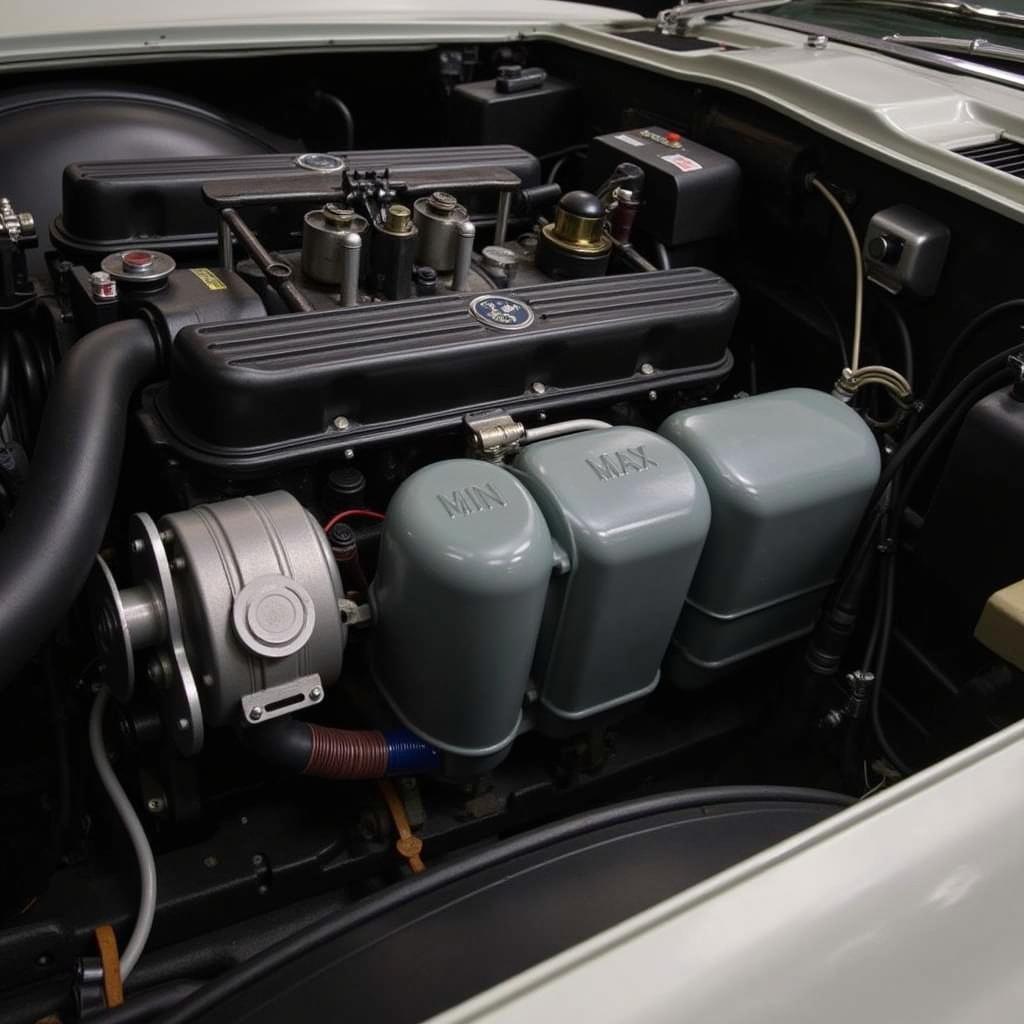A glowing brake warning light on your classic 1967 Corvette dashboard is a clear signal that something needs attention. While it might seem alarming, it doesn’t necessarily mean a catastrophic brake failure is imminent. This article will guide you through the potential causes of this warning light and provide you with the knowledge to address them, ensuring your vintage ride stays safe and enjoyable.
Understanding Your 1967 Corvette’s Brake System
Before delving into the warning light’s meaning, it’s helpful to understand the basics of your Corvette’s braking system. This iconic model typically features a four-wheel hydraulic drum brake system, meaning hydraulic pressure is used to push brake shoes against the drums, slowing the car down. The brake warning light is an essential safety feature within this system, alerting you to potential issues that require attention.
Common Causes of a 1967 Corvette Dashboard Brake Warning Light
The brake warning light on your 1967 Corvette’s dashboard can illuminate for several reasons, ranging from minor issues to more serious concerns:
-
Low Brake Fluid Level: This is the most common cause. The brake fluid reservoir, usually located under the hood on the driver’s side, has a “MIN” and “MAX” marking. If the fluid level is below the “MIN” mark, it triggers the warning light.
-
Worn Brake Shoes: Over time, the brake shoes naturally wear down. If they become too thin, it can affect the hydraulic pressure within the system, triggering the warning light.
-
Brake Fluid Leak: A leak in the brake lines, hoses, or wheel cylinders can lead to a drop in brake fluid level and activate the warning light. It’s crucial to identify and repair any leaks immediately.
-
Faulty Brake Light Switch: The brake light switch is responsible for activating your brake lights when you press the pedal. If it malfunctions, it can also trigger the brake warning light.
-
Parking Brake Engaged: Though often overlooked, ensure the parking brake is fully disengaged. Even slightly engaged can illuminate the warning light.
-
Master Cylinder Issues: The master cylinder plays a vital role in distributing brake fluid pressure. Internal issues within the master cylinder, such as a leaking seal, can lead to a loss of pressure and illuminate the warning light.
 Checking the Brake Fluid Reservoir
Checking the Brake Fluid Reservoir
Troubleshooting the Brake Warning Light
If the brake warning light comes on, don’t panic. Here’s a step-by-step guide to help you troubleshoot the issue:
- Check the Parking Brake: Ensure the parking brake is fully released.
- Inspect Brake Fluid Level: With the engine off, open the hood and locate the brake fluid reservoir. Check the fluid level. If it’s low, add the correct type of brake fluid (usually DOT 3) until it reaches the “MAX” line.
- Inspect for Leaks: Carefully examine the brake lines, hoses, and wheel cylinders for any signs of leakage, such as wet spots or drips.
- Check Brake Light Operation: Have someone press the brake pedal while you observe if all brake lights illuminate properly.
- Consider Professional Diagnostics: If the warning light persists after these checks, or if you find a leak, it’s crucial to seek professional help from a qualified mechanic experienced with classic Corvettes.
Importance of Prompt Attention
Ignoring a brake warning light can have serious consequences, compromising your safety and potentially leading to costly repairs. Addressing the issue promptly ensures your 1967 Corvette remains a joy to drive while maintaining its value and your peace of mind.
“Remember, any brake issue, even seemingly minor, should be taken seriously,” says John Miller, a veteran mechanic with over 30 years of experience restoring classic American cars. “Early detection and prompt repairs are essential for maintaining a safe and reliable braking system in a classic car like the 1967 Corvette.”
Maintaining Your Corvette’s Brake System
Regular maintenance is key to preventing brake issues and ensuring the longevity of your 1967 Corvette’s braking system:
- Check Brake Fluid Regularly: Inspect the brake fluid level at least once a month and top it off if necessary.
- Flush Brake Fluid: It’s recommended to flush the brake fluid every two years or as recommended by your service manual.
- Inspect Brake Lines and Hoses: Regularly inspect the brake lines and hoses for signs of cracking, wear, or damage.
- Listen for Unusual Noises: Be attentive to any unusual noises like squeaking, grinding, or scraping when applying the brakes.
Conclusion
The brake warning light on your 1967 Corvette’s dashboard serves as a crucial safety alert. Understanding its potential causes and taking prompt action ensures a safe and enjoyable driving experience. Regular maintenance and timely repairs will keep your Corvette’s braking system in optimal condition, allowing you to confidently enjoy this classic American sports car for years to come.
